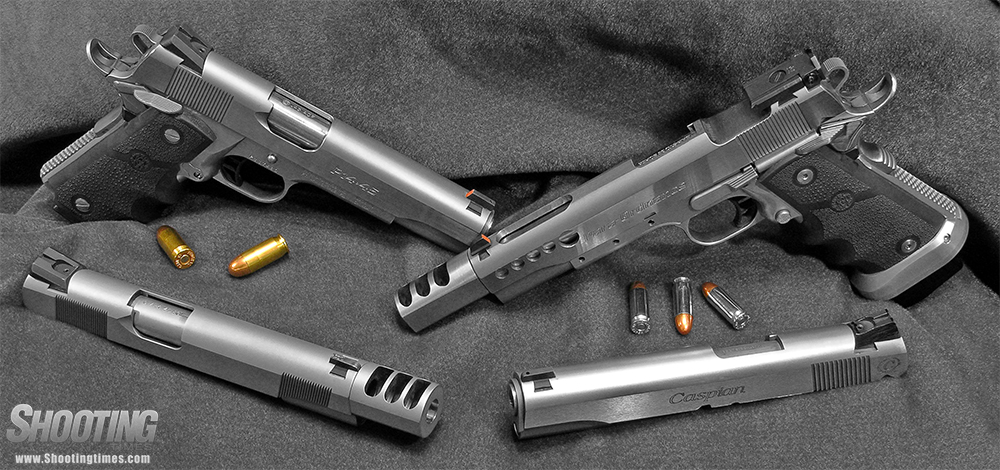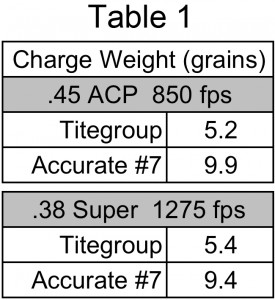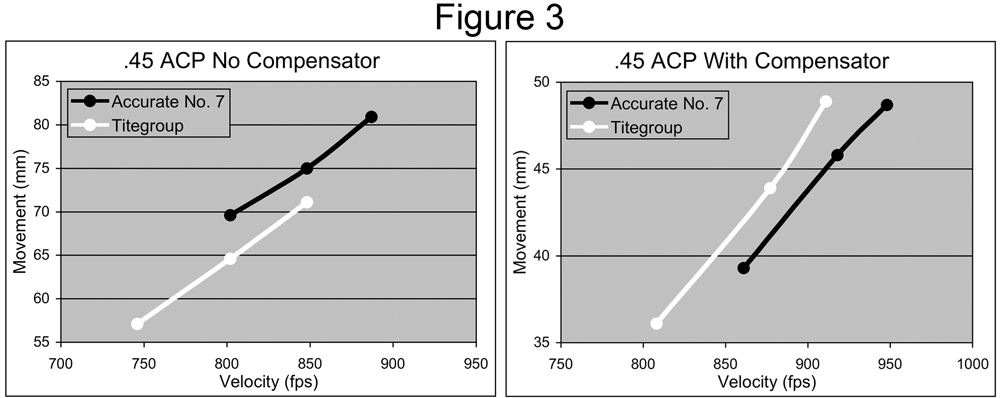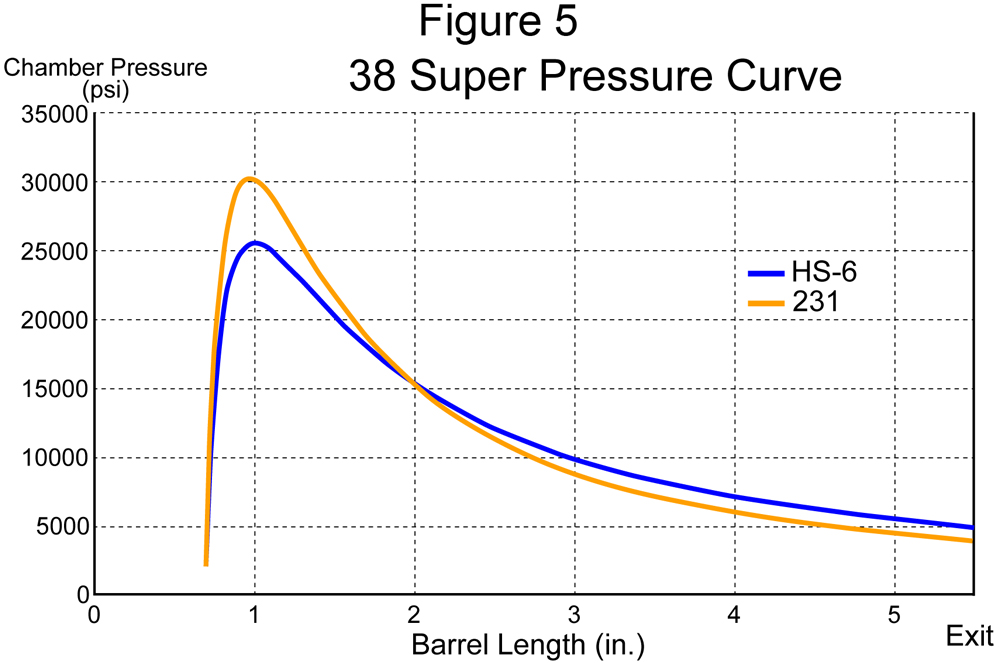April 09, 2014
By Brad Miller, Ph.D.
 We often hear arguments that high pressure is required to make a pistol compensator work properly. Some people claim that compensators are ineffective with .45 ACP because the cartridge doesn't produce enough pressure. It is a relatively low pressure round with a maximum average pressure limit of 21,000 psi (or 18,000 copper units of pressure (CUP) when measured with that method).
We often hear arguments that high pressure is required to make a pistol compensator work properly. Some people claim that compensators are ineffective with .45 ACP because the cartridge doesn't produce enough pressure. It is a relatively low pressure round with a maximum average pressure limit of 21,000 psi (or 18,000 copper units of pressure (CUP) when measured with that method).
Some argue that compensators only work on high-pressure cartridges, like the .38 Super. Its maximum average pressure limit is 36,500 psi (33,000 CUP), and there's no doubt compensators work very well with .38 Super.
I set out to test if a compensator works with the .45 ACP like it does with the .38 Super. During testing, it was important to understand how gunpowder contributes to recoil, and not just that adding more gunpowder produces more recoil. Because you're also increasing velocity recoil goes up regardless. The key is more gunpowder weight for the same velocity.
Gunpowder charge weight contributes to the overall recoil force. Newton's Second Law describes force as the product of mass and acceleration.
Advertisement
F = m*a; Force equals mass times acceleration
The gunpowder's weight is part of the mass that exits the end of the barrel (the ejecta) in the form of gas along with the bullet. Formulas that calculate recoil force also require the gunpowder weight, bullet weight and velocity for an accurate calculation. This means that if you compare two different gunpowders that produce the same velocity but require different charge weights, the powder that requires a larger charge weight produces more recoil.
More gunpowder weight means a greater volume of gas. Compensators deflect gas to help tame recoil. Pistol compensators usually direct the bulk of the gas upwards through large ports. As the gas blasts upward, it produces an equal amount of downward force to help counteract muzzle climb. The downward force is also explained by Newtonian physics that for every action there is an opposite and equal reaction: force up = force down.
Advertisement
In a non-compensated pistol, gunpowder with a higher charge weight produces more gas and thereby more recoil and muzzle rise than a lower charge weight gunpowder even though they produce the same velocity with the same bullet. Effective compensator function will reverse this gas volume effect on recoil; the higher charge weight gunpowder's additional gas will generate more downward force and produce less muzzle rise than a lower charge weight gunpowder.
Testing
Four gun configurations were required for the test, a compensated and non-compensated version for each caliber — .45 ACP and .38 Super. The non-compensated configuration was used to show how gunpowders normally affect recoil, which helps to demonstrate how compensators work to reduce muzzle rise.
The .45 ACP test gun was a Para Ordnance P14-45 with a factory 5-inch barrel plus an additional Les Baer slide with a Clark 5.5-inch threaded barrel equipped with a three chamber/port compensator. The .38 Super test gun was a Para Ordnance P18-9 with a 5.5 inch Bar-Sto threaded bull barrel with a three chamber/port compensator plus an additional Caspian slide with a 5 inch Kart barrel. The two compensators had nearly identical port sizes. All the ports vented upward as neither compensator had side ports.
The guns were fired from a Ransom Rest. Measuring the distance that the gun moves in the Ransom Rest indicates relative recoil. Velocity was measured at about 12 feet with a Shooting Chrony chronograph. Ten rounds were tested with each load.
Test ammunition was loaded in same-headstamp brass with 230 grain FMJ bullets in the .45 ACP and 115 grain JHP bullets in the .38 Super. Two gunpowders were used; Hodgdon Titegroup and Accurate No. 7. Three charge weights were loaded for each gunpowder. It's important to note Titegroup is a fast burning gunpowder and requires a much smaller charge weight than the slower burning Accurate No. 7 for the same velocity.
 Charge weights required to achieve 850 fps in the .45 ACP and 1275 fps in the .38 Super were calculated with linear regression based on the results with no compensator and are shown in Table 1. The difference in charge weights between the two gunpowders is almost two-fold for both calibers.
Charge weights required to achieve 850 fps in the .45 ACP and 1275 fps in the .38 Super were calculated with linear regression based on the results with no compensator and are shown in Table 1. The difference in charge weights between the two gunpowders is almost two-fold for both calibers.
Data from the .38 Super illustrates how the differences between the two gunpowders affect recoil. In a standard pistol with no compensator, Accurate No. 7 powder produces more recoil than Titegroup powder for the same velocity. Figure 2 shows the recoil profiles of the two gunpowders. The line representing Accurate No. 7 is above the Titegroup line, indicating more gun movement (recoil) for the same velocities. With a compensator, the position of the profiles is reversed, and the Accurate No. 7 line is now below the Titegroup line. Thus, the higher charge weight gunpowder produced more movement with no compensator and less movement with a compensator. Titegroup showed a 68% reduction in gun movement with a compensator, while Accurate No. 7 showed a greater reduction of 79%. This shows the charge weight/gas volume compensator effect: the higher charge weight gunpowder shows a greater reduction in muzzle rise.

Data from the .45 ACP shows the same result (Figure 3). Accurate No. 7 produces more movement than Titegroup with no compensator, and less movement with a compensator. Titegroup showed a 42% reduction in gun movement, and Accurate No. 7 showed a larger 50% reduction in gun movement, consistent with the charge weight/gas volume effect of a compensator.

These data demonstrate that a compensator works effectively with the low-pressure .45 ACP cartridge and in the same manner as the high-pressure .38 Super. The .45 ACP showed less overall recoil reduction (42-50%) with the compensator than the .38 Super (68-79%). This is most likely attributable to the .45's greater recoil in general due to much heavier bullets.
Part 2: Chamber Pressure
I took a second approach to the pressure versus gas volume debate. I made a comparison between gunpowders with loads of "known" published pressures to compare the effect of different pressures on recoil.
The published numbers represent peak chamber pressure. How this translates into gas pressure at the compensator is a different issue. Pressure at the compensator is what matters, because this is where the force is applied. Therefore, the chamber might not be the right place to measure pressure for this purpose, but this test is necessary to evaluate the role of chamber pressure.
Gunpowders were selected based on published pressure and charge weight data available on Hodgdon's website. Again, I tested .45 ACP and .38 Super.
I tried several gunpowders from the Hodgdon data (Super Target, Titegroup, AutoComp, 231, Longshot, HS-6) with the hope of getting some that would yield similar velocities since one cannot predict the actual velocities produced by a particular gun. Similar velocities are necessary for this comparison.

The data are from Winchester 231 and Hodgdon Longshot in the .45 ACP, and 231 and Hodgdon HS-6 in the .38 Super (Table 2). The 231 is the high pressure load for both calibers. Charge weight differences between the low and high pressure loads were at least one grain.
The actual pressures in my guns would likely not exactly match the published pressures, but the relative differences in pressure should be maintained since these reflect characteristic differences of the gunpowders.
I used the same bullet and overall length as the Hodgdon data: Hornady 230-grain FMJ FP bullets for the .45 ACP loaded at 1.200-inches overall length (OAL) in same-headstamp cases, and Hornady 115-grain XTP bullets at 1.245-inches OAL in same-headstamp cases for the .38 Super. Recoil and velocity were measured as previously described. Ten rounds were fired with each load.
 In the .45 ACP, Longshot (LS) powder, with its larger charge weight, produced more movement than 231 powder with no compensator but less movement with a compensator (Figure 4). Similarly, in the .38 Super, HS-6 powder, with its larger charge weight, produced more movement than 231 powder with no compensator but less movement with a compensator. Note that Longshot and HS-6 both produced more velocity than 231 with a compensator even though they had less movement.
In the .45 ACP, Longshot (LS) powder, with its larger charge weight, produced more movement than 231 powder with no compensator but less movement with a compensator (Figure 4). Similarly, in the .38 Super, HS-6 powder, with its larger charge weight, produced more movement than 231 powder with no compensator but less movement with a compensator. Note that Longshot and HS-6 both produced more velocity than 231 with a compensator even though they had less movement.
These results show that higher chamber pressure does not mean better compensator function. If it did, higher chamber pressure would produce less movement with the compensator. It didn't, in fact the higher-pressure 231 loads showed more movement with a compensator than the lower-pressure loads. The lower pressure loads also produced more movement with no compensator. This test affirms that gas volume is the key player in recoil force.
Muzzle Pressure
How does chamber pressure relate to pressure at the muzzle? Chamber pressure peaks long before the bullet exits the barrel, leaving considerable time for the pressure to fall. More gas volume from the greater charge weight might result in more residual pressure at the compensator that is not reflected by peak chamber pressure. More gas volume in the same space (trapped in the barrel prior to bullet exit) likely results in more muzzle pressure when released by the bullet's exit.
I used QuickLOAD interior ballistics software (version 3.8.0.2) to assess gas pressure at the muzzle. QuickLOAD predicts values based on theoretical models, so its output is a theoretical estimate. The software calculates muzzle pressure, and I explored whether it would show that a larger charge weight results in higher muzzle pressure even though it had less chamber pressure.
 QuickLOAD's calculations for the loads used in this test showed that muzzle pressures from HS-6 and Longshot powders were greater than 231 even though they produced lower peak chamber pressure (Table 3). The pressure curve generated by QuickLOAD (Figure 5) illustrates the difference between the two gunpowders tested in the .38 Super. HS-6 (blue line) has a lower peak pressure than 231 (orange line), but retains higher pressure when the bullet exits (right side of figure). This could explain why charge weight has such a large impact on compensator function.
QuickLOAD's calculations for the loads used in this test showed that muzzle pressures from HS-6 and Longshot powders were greater than 231 even though they produced lower peak chamber pressure (Table 3). The pressure curve generated by QuickLOAD (Figure 5) illustrates the difference between the two gunpowders tested in the .38 Super. HS-6 (blue line) has a lower peak pressure than 231 (orange line), but retains higher pressure when the bullet exits (right side of figure). This could explain why charge weight has such a large impact on compensator function.
The larger volume of gas might also take more time to vent, which could add to its effect.

Summary
Compensators redirect force by diverting gas to reduce muzzle rise, and the gas volume concept explains how a compensated pistol behaves in both low and high pressure cartridges. A compensated .45 ACP behaves just like a compensated .38 Super. Higher chamber pressure does not mean better compensator function, but greater gas volume does. The larger gas volume likely results in more gas pressure at the muzzle/compensator. To maximize a compensator's effectiveness, select a gunpowder that requires a large charge weight.
Para Ordnance pistols used for this test with their conventional and compensated upper assemblies.
.38 Super recoil movement without and with a compensator. The dots indicate charge weights.
.45 ACP recoil movement without and with a compensator. The dots indicate charge weights.
Velocity and recoil movement with published charge weights and pressure.
Pressure curve from QuickLOAD (redrawn from original for improved resolution) showing pressure as the bullet moves down the barrel until exit.
